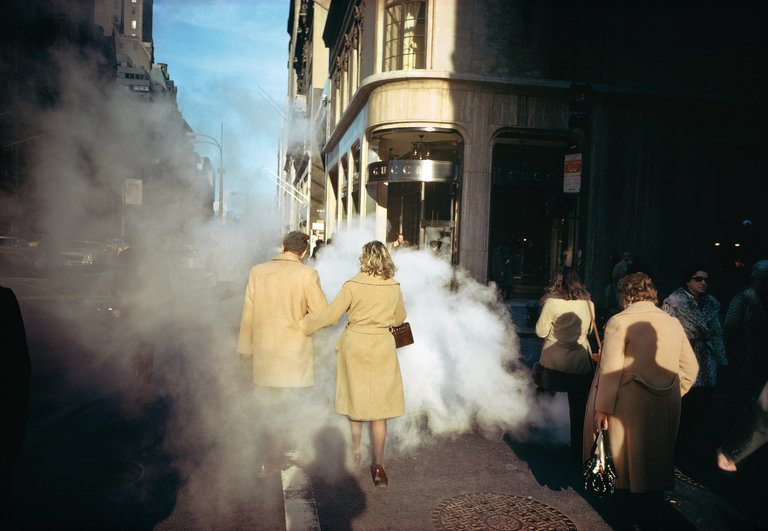Joel Meyerowitz’s Career Is a Minihistory of Photography

‘‘New York City, 1975.’’ Credit Joel Meyerowitz. From the Howard Greenberg Gallery.
- Now wait a second, is this magic? Or has it all been carefully arranged with actors, lighting and special effects? The truth is more surprising: It’s neither. It’s simply a picture snapped by Joel Meyerowitz on a New York City street one day in 1975. No faces are immediately evident, just figures in camel-colored coats turned away from us, a puff of smoke with two people suspended in it. No, four people, if you count those shadows, six if you count the backs on which the shadows fall. In fact there are seven people, if we count the additional shadow in the foreground, the photographer’s — and further figures emerge as the eye adjusts to the deep background. It is a picture that just won’t sit still.
Meyerowitz began to work as a street photographer in the early 1960s and quickly became a virtuoso of the craft. He was inspired by the example of Robert Frank, whose work was full of poetic melancholy, though what first struck Meyerowitz was the balletic grace with which Frank moved while photographing. Later, he went out roaming with Garry Winogrand, who was frenetic and indefatigable. A great street photographer needs two distinct talents: the patience to lie in wait for unanticipated moments and the skill to catch them with the click of a shutter. Meyerowitz had both, whether he was shooting in black and white or in color. The color work is what he’s better known for, photographs that, to begin with, were brash and often jubilant, a world away from Frank’s gloom.
In many of his images from the 1960s and 1970s, everything falls into place in a witty or amazing way. Some of them are like a good joke that can be told more than once, or like a quick little fable. “New York City, 1975” rises above this group of early pictures by being less a smart one-liner and more an open-ended koan: declarative to begin with, but then becoming charged with some palpable but elusive wisdom. Certain pictures are easy to see but hard to make.

“Hartwig House, Truro, Massachusetts, 1976.”
- This is my idea of heaven: the uncluttered interior of a house on a summer’s day, light and silence. One door opens out to another, and beyond that another, the final door revealing greenery outside. In a bedroom off to one side, partly visible, is a bed with a white blanket. Pale rugs line the hardwood floor and framed pictures hang on the off-white walls; the whole ensemble as compact as a short story.
Hard to believe that this picture was made by the same man responsible for an agile photograph like “New York City, 1975.” “Hartwig House, Truro, Massachusetts, 1976” was made only one year later, but something has certainly changed in Meyerowitz’s seeing. What remains is an extreme visual eloquence, an eloquence that is also there in the way he talks about photography and in the way he teaches. (I took a weekend master class with him years ago, and I’ve yet to meet anyone who matches his ability to describe what is happening in a given photograph.)
The photo of the Hartwig House is the first photograph Meyerowitz made with an 8-by-10-inch view camera. Certain small stylistic adjustments are expected when subject matter shifts, and for photographers, this is a difference often heralded by a change of camera. With a tripod and much larger negative, the “action” in the picture is now all in the thoughtfulness and calm description, the warm light that suffuses everything, the unfailing verticals of the doors and walls.
Susan Sontag once noted that “seeing tends to accommodate to photographs.” Once the thrill of originality fades, we are often left with the merely picturesque. A landscape by Edward Weston is absorbing; a landscape in the style of Weston less so. Diane Arbus revolutionized portraiture, but her numerous imitators cannot command our interest to the same degree.
The renovation of photography’s possibilities happens generationally. But within this slow evolution are faster cycles, certain artists who keep it moving so that their individual oeuvres come to constitute minihistories of photography: artists like Paul Strand, Berenice Abbott and Joel Meyerowitz.

‘‘Cocktail Party, Wellfleet, Massachusetts, 1977.”